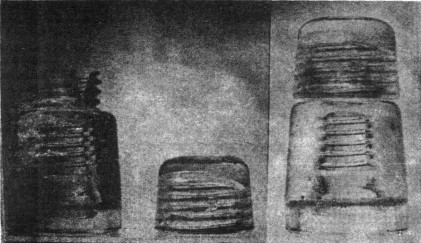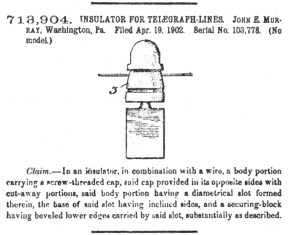Research Division
Reprinted from "INSULATORS - Crown Jewels of the Wire", April 1977, page 29
Dear Don and Dora Harned,
Here's some history on the New York and Erie Railroad and its telegraph.
In 1851 the New York & Erie Railroad, after nearly 20 years of struggle
and of financial vicissitudes, had finally linked the Great Lakes with the
Atlantic coast. This road was 460 miles from Piermont on the Hudson to Dunkirk
on Lake Erie. Appleton's Illustrated Handbook of American Travel, published in
1857, devotes several pages to a description of this remarkable achievement in
railroad extension, and among other things says: "An interesting feature of
this road is its own telegraph which runs by the side of the road and has its
operator in nearly every station house. This telegraph has a double wire
enabling the company to transact the public as well as their own private
business."
Graham Barnes
Painted Post, N.Y.
Dear Dora Harned,
I'm finally getting back into collecting, after a layoff of about two years
because of so many other commitments.
I was going over my old Crown Jewels last night when I saw the insulator on
page 7, September 1971 issue (see below).
The other insulator is a two piece unit embossed with a "B" on each
side of the top. I would assume the wire was put in a slot and the top was
screwed on. This insulator was found by Fred Griffin and Margaret Rainey of
Palatka, Florida.

What then occurred to me was another of my passions, that of looking through
old patent books. It occurred to me that I had seen the patent for this
insulator, and after finding it I am pretty convinced it is. The fact that the
embossing is just the letter "B" , probably Brookfield, corresponds
with the date of the patent (November 1902) as a period when Brookfield used
only the letter "B" on some of their styles.
 |
Image text:
713,904. INSULATOR FOR TELEGRAPH-LINES. JOHN E. MURRAY, Washington, Pa. Filed
Apr. 19, 1902. Serial No. 103.778. (No model)
Claim--In an insulator, in combination with a wire, a body portion carrying a
screw-threaded cap, said cap provided in its opposite side with cut-away
portions, said body portion having a diametrical slot formed therein, the base
of said slot having inclined sides, and a securing-block having beveled lower
edges carried by said slot, substantially as described.
|
At left is a copy of the patent. If Fred Griffin and Margaret Rainey are
still subscribers, this may be of interest to them. It might help with the
purpose of design of this insulator. I can only envy them or whoever owns that
beautiful insulator now.
Thanks again.
Robert D. Cirillo
|
